Minimally Invasive Laser Ablation
The tumor deep in Tom’s brain was destroyed using heat from a laser. Laser therapy can reach previously inoperable tumors.
As a quality control manager for U.S. Steel, Tom Kremm is diligent and methodical, following routines and specifications to the letter. But at Henry Ford, his treatment for a deep-brain tumor was more than routine. And he may have met his match when his team of precision-oriented cancer experts did what would have been impossible just years ago. They killed the cancer.
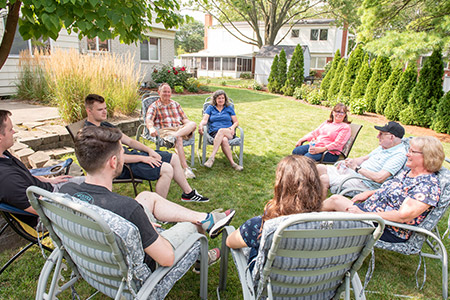 Tom keeps a tight schedule: bedtime at 7:30 p.m., awake at 2:30 a.m., arrive at work at 4:00 a.m. He doesn’t smoke or drink. He lives with his close-knit family in Livonia where he was raised. His parents lived around the block. Tom, his wife and sisters took care of his parents who were in their 90s. He planned to live to be the same age.
Tom keeps a tight schedule: bedtime at 7:30 p.m., awake at 2:30 a.m., arrive at work at 4:00 a.m. He doesn’t smoke or drink. He lives with his close-knit family in Livonia where he was raised. His parents lived around the block. Tom, his wife and sisters took care of his parents who were in their 90s. He planned to live to be the same age.
At first, the sudden numbness on his face and right side didn’t bother him. But soon he created a bar chart to graph the episodes that occurred 1-13 times a day.
His general practitioner at Henry Ford ordered an MRI and found a tumor. Another MRI suggested potential glioma. That meant, several layers of the brain sat on top of the tumor, and the tumor had poorly defined boundaries. It was considered incurable.
“It was a complete shock to me. The last thing I expected at age 62 was to be diagnosed with a brain tumor,” says Tom.
In October 2020, senior staff neurosurgeon Adam M. Robin, M.D. at Henry Ford performed minimally invasive laser ablation to kill the tumor cells. In real time, MRI imaging guided the laser ablation system.
Three laser fibers were placed through three tiny openings in Tom’s head. The positions were confirmed, and then light energy was delivered to the targeted cancer cells. The temperatures were monitored and increased to destroy cancer tissue.
The tumor deep in Tom’s brain was destroyed using heat from a laser. Laser therapy can reach previously inoperable tumors.
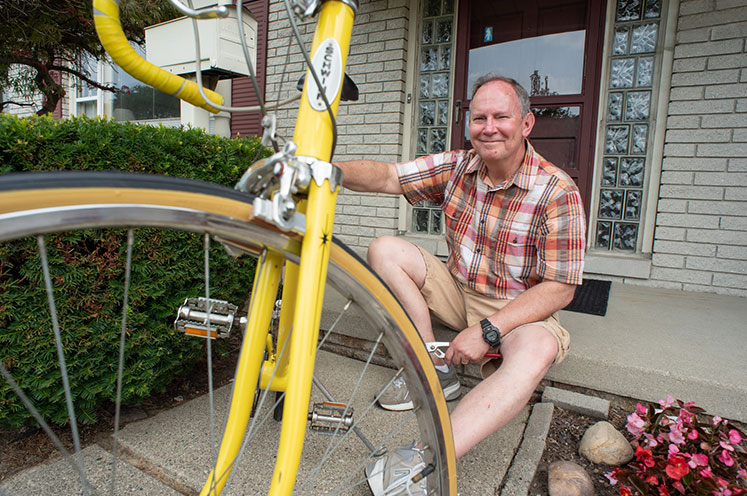
“It was amazing! I had minimal side effects. I didn’t even take pain medication after the surgery. The biggest side effect was from the steroids to prevent swelling in the brain,” says Tom. “To be able to drill into your brain and miss all those critical areas for motor coordination, vision or speech and still get the job done – is amazing!”
The second stage of Tom’s treatment occurred in February 2021 and required two more laser fibers to remove the remaining tumor tissue. He stayed in the hospital overnight. Then he recovered for three weeks at home and returned to work.
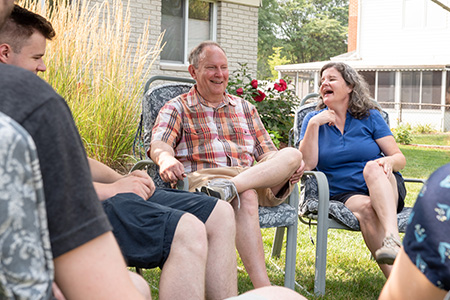 “Overall, there was a small surgical footprint,” says Dr. Robin. “The tiny incisions required only a little skin glue. In the past, this type of surgery would have been done with an open craniotomy while the patient was awake. Open surgery in this location can be associated with higher stroke rates,” says Dr. Robin.
“Overall, there was a small surgical footprint,” says Dr. Robin. “The tiny incisions required only a little skin glue. In the past, this type of surgery would have been done with an open craniotomy while the patient was awake. Open surgery in this location can be associated with higher stroke rates,” says Dr. Robin.
“I am nothing but amazed by Dr. Robin and Dr. James Snyder, my neuro-oncologist, and the staff. Everyone was excellent, very efficient. They had their act together in the time of Covid. I can’t say anything too good about the surgery. From the very beginning, Dr. Robin was very confident. I have no doubt that he’s probably one of the best in the business. I couldn’t have had a better turnout,” says Tom.
Henry Ford was one of the early adapters of laser ablation, also known as laser interstitial thermal therapy (LITT). Although other health systems use the technology, Henry Ford handles cases where special experience is required to use laser ablation technology for additional treatment of certain deep brain tumors, says Dr. Robin.
“I think it was by Providence that I ended up at Henry Ford. It’s easier to go into surgery knowing the ultimate control is with God. Whatever his plan is, it’s OK by me,” says Tom. He calls himself a private man, “I only told my family and a few people. I didn’t make a hoopla.”
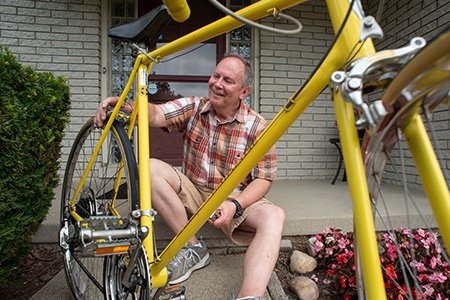 For his three young adult kids – two are studying engineering and one studies welding – the experience became a teaching moment. “How you handle things translates to your children and allows them to learn from it. You have to play the hand you’ve been dealt,” says Tom, sitting next to his wife in their minimalist living room. Basic furniture. One picture on the wall. Books are shelved on the first and second floors of their colonial home and in the basement, and his refurbished Schwinn 10-speed bikes, a hobby of Tom’s are showcased.
For his three young adult kids – two are studying engineering and one studies welding – the experience became a teaching moment. “How you handle things translates to your children and allows them to learn from it. You have to play the hand you’ve been dealt,” says Tom, sitting next to his wife in their minimalist living room. Basic furniture. One picture on the wall. Books are shelved on the first and second floors of their colonial home and in the basement, and his refurbished Schwinn 10-speed bikes, a hobby of Tom’s are showcased.
“Having less leads to a happier and more productive life. It keeps you on your game. You can’t take possessions with you, and life if more than that,” says Tom.
During the three-month break between the surgeries, Tom’s mother passed away and, as always, coping meant taking life one day at a time. His parents had been his role models for good self-care. Now, Tom, his wife and his two sisters care for his dad every day.
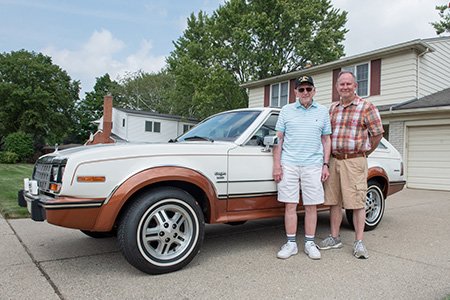 Tom and his father take pride in his late-mothers 1983 AMC Eagle – often competing (and winning awards!) at car shows. They continue this tradition together, not letting a brain tumor stand in the way.
Tom and his father take pride in his late-mothers 1983 AMC Eagle – often competing (and winning awards!) at car shows. They continue this tradition together, not letting a brain tumor stand in the way.
Tom has advice for preserving good health. “If something isn’t normal, the earlier you jump on it, the outcome is usually better.”
His future is tempered: “This is a non-curable condition. They can do what they can do. But the odds are this will come back. My hope is that it’s treatable and it doesn’t come back. I’m very positive about what has happened so far. I can’t ask for anything better. I can’t say enough good things about Henry Ford Health.”
We use cookies to improve your website experience. By using this site, you agree to our Terms of Use. Read our Internet Privacy Statement to learn what information we collect and how we use it.